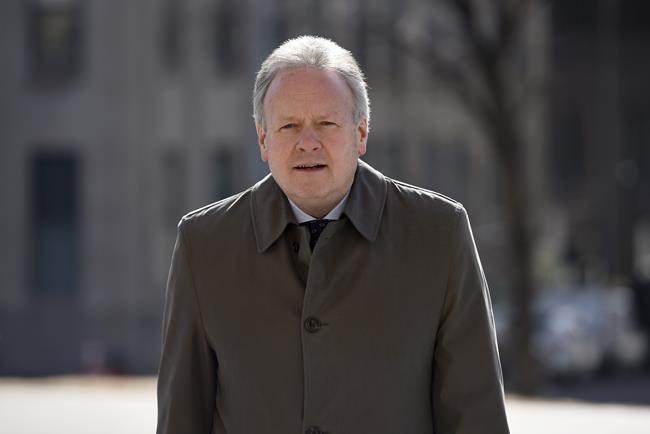OTTAWA — In February 2020, the governor of the Bank of Canada was testing the seal on his N95 face mask by trying to smell the scented gas his security team pumped at him.
In that moment, it occurred to him that COVID-19 might turn out to be more than just a health concern.
Stephen Poloz needed the protective mask in case he contracted the virus during a flight to Australia for an annual economic meeting. By the time he was in Riyadh, Saudi Arabia a week later for a meeting of G20 central bankers and finance ministers, the virus's accompanying economic concerns were becoming apparent in places like Italy and Singapore.
Poloz had his own pressing economic concerns. Oil prices were plummeting, enough so that the Bank of Canada's senior leadership was ready to cut its key policy rate by half a percentage point in response, even as COVID-19 cases rose worldwide. The cut, at the time the first since 2015, came March 4, a date already scheduled for a rate announcement.
“We believe we've done a lot there to cushion a blow," Poloz said at a news conference following a Toronto speech the next day. "We don't know how big the blow might be, so we'll be looking at ways to figure out how big that blow might be and how long it might last."
Before he faced the media, Poloz recalled scrubbing his hands, after shaking hands of many in the packed ballroom who came to hear him speak.
So began a month like no other at the central bank. After that first move brought the rate down to 1.25 per cent, Poloz oversaw two more cuts and the launch of a bond-buying program to prop up the economy as the first wave of the pandemic crashed on Canada's shores.
Poloz, now with the Lawrence National Centre for policy and management at Western University, recalled the events in detail during a recent interview with The Canadian Press.
The day after the speech, Poloz called a snap meeting with the heads of the country's big banks. The lessons of the 2008-09 financial crisis hung over the meeting, where the governor and his colleagues emphasized the importance of keeping credit flowing to companies and suggested giving mortgage holders payment holidays if things got really bad.
Poloz recalled speaking the same day with the deputy minister at the Finance Department, and with Prime Minister Justin Trudeau at the end of the day.
A week later, on the morning of Friday, March 13, then-finance minister Bill Morneau called. The government planned to unveil an economic aid package that afternoon, and Morneau wanted Poloz to join him in hopes of projecting some confidence. Preventing a panic was top of mind.
"That's when you get a real recession," Poloz said. "It's hard to restore confidence after it's been shattered."
Poloz had to check with his deputies on the central bank's governing council, which was already considering cutting rates by another 0.5 per cent. They weighed cutting rates that day, rather than wait until mid-April for the next scheduled announcement and release of the bank's monetary policy report.
In a few hours, the decision was made: The bank would drop the rate by another half a point, to 0.75 per cent.
Poloz's chief of staff, Jill Vardy, and Carolyn Wilkins, then second-in-command at the Bank of Canada, worked out the wording of a press release. Poloz prepped for media questions. His opening statement was the last item to be finished, delivered to Poloz minutes before we went before the cameras with Morneau and the superintendent of financial institutions.
"(Morneau's) insight into having the two of us there was a good one," Poloz said. "At the time, there was no inkling that we might have anything to enact. It kind of just came together."
The joint appearance created some unusual side-effects: When Poloz agreed to appear alongside Morneau the next week, jittery investors took it as a bad sign. The bank had to take the unusual step of issuing a notice that it wasn't planning to cut rates to calm markets.
He said the rate-setting group still hoped to wait for the scheduled rate decision on April 15 to make a further drop, giving the bank time to put together a comprehensive package.
"In the background, we knew things were caving in and we were going to need to probably make the third move," Poloz said. "And sooner than later."
Other central banks, with whom Poloz was in regular contact, were slashing rates and heading to what's known as the "lower effective bound" — basically as low as rates can go without turning negative.
What Poloz said tipped the scales toward action was a distortion at the front end of the money market, where dealers were paying more to finance their inventories of government debt than they actually earned on the debt itself. Poloz said they couldn't let that persist until mid-April.
So early Friday morning, March 27, the Bank of Canada sent out a notice. The key rate was going to 0.25 per cent. It also launched bond-buying programs so the financial system wouldn't freeze up.
His tenure as governor ended last June, and he's been an observer since.
Thus far, the economy looks OK, Poloz said, noting that there are big fiscal decisions looming that will take some real orchestration.
Kind of like fighting a fire.
That was the analogy Poloz used one year ago when he explained the month of monetary moves by saying a firefighter hasn't been criticized for using too much water.
After trying to douse the economic flames, he is intently watching the rebuild.
"I can't wait to see how it all turns out."
This report by The Canadian Press was first published March 13, 2021.
Jordan Press, The Canadian Press


